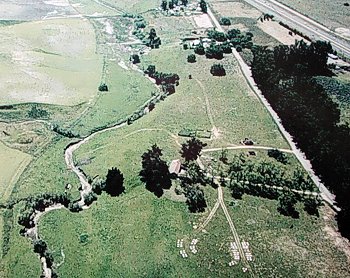As I sat there my thoughts went to the deep past of the Adobe, and to its future. It was only a few days ago that I was in Sacramento to help fight for the future of the Adobe, joining Dana Adobe Nipomo Amigo board members Herb Kandel and Allen Daurio as they worked to secure a grant.
The Dana Adobe, which stands at the edge of the Nipomo Mesa overlooking the Nipomo Valley, has a commanding view of the Nipomo Valley. Captain William Goodwin Dana managed his expansive 38,000 acre rancho from here. This rancho, granted to him by the Mexican government, stretched from the top of the Temetatte Ridge in the east to the dunes in the west, from Los Berros Creek in the north to the Santa Maria River in the south.
In 1837, when construction on the Dana Adobe began, Nipomo was part of a wild frontier still dominated by grizzly bears and oak trees. Numerous Chumash villages dotted the land around Nipomo, lending their names to places such as the Temetatte Ridge and Nipomo proper.
The Chumash legacy is physically evident throughout the area in the form of depressions in rocks near the foothills, once used for grinding acorns, and the Dana Adobe itself, which was constructed largely with Native American labor.
The view from the back porch of the Adobe (which originally was the front porch, facing El Camino Real) is just about the same view that Captain Dana and his contemporaries enjoyed. It takes little imagination to remove the few vestiges of modern society which have crept into the landscape—the cars jolting down Thompson Avenue, fences, power lines, and a handful of houses.
Taking a walk through the Adobe grounds offers a glimpse into the natural history of the place. The Captain's tree, a majestic old sycamore to the north of the Adobe planted by Captain Dana, seems to embrace the structure with its open branches. Numerous of bees busily dart in and out of a natural beehive in its great trunk.
Downslope from the Adobe, willow trees line the creekside. A clay mine at the bank of the creek supplied the material for the adobe bricks. During the part of the year when the mustard plants are in bloom a line of yellow flowers emerges in the fields adjacent to the creek, marking the general path of El Camino Real. Travelers upon this ancient roadway used to to discard of their seeds as they went.
The Adobe was an important place—one of four stopover points on the original mail route from Monterey to Los Angeles, a place where Captain John C. Fremont rested his troops, where policies of the early California government were discussed. A center of great cultural diversity, the Adobe brought together Native Chumash, Mexican and American peoples.
The Adobe is also unique in that it survives today with its viewshed relatively intact and the acres around it untouched by development. The potential for the future of the Adobe as a historic park is limitless, and this is precisely the point that Kandel made to the board of the California Cultural and Historical Endowment (CCHE) when we traveled to Sacramento.
It was an honor (and quite an interesting experience) for me to travel to the state capitol to help represent our little hometown. The Dana Adobe was one of over fifty projects seeking a share of $43 million in state funding. That the Adobe received funding—$861,000 of it—from this state-wide board is a testament not only to the hard work volunteers at the Adobe, but also to its historical significance to the state of California.
The Dana Adobe is a resource for the entire community. There are countless tales to be told about the people who lived here: of how they interacted with the Natives, of how they conducted business, of how the helped to lay the foundation for the future of all Californians.
So this next weekend plan a visit to the Dana Adobe. Chances are you'll learn something you didn't know about Nipomo's rich history.




No comments:
Post a Comment